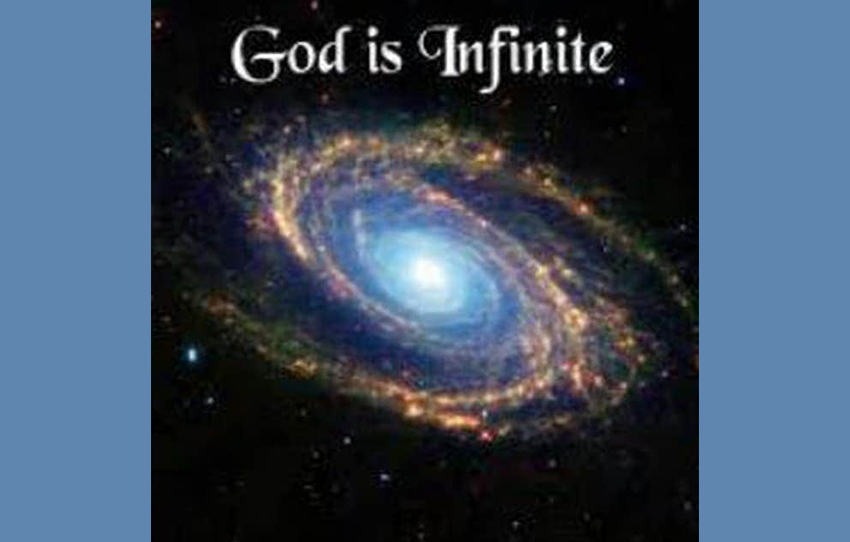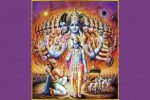NAME 1
Viśvam
Viśva means all pervading. The first nāma gives a preview of what is going to be discussed in this Sahasranāma. The Brahman alone is all pervading. He is the cause, and the effect of which is the universe. By commencing this Sahasranāma with the word ‘Viśvam’ it clearly means that this Sahasranāma is going to discuss about the non-dualistic Brahman. MuṇḍakaUpaniṣad (II.i.10) says ‘puruṣaevedaṁviśvaṁ’ which means that the Brahman is the universe. The same Upaniṣad reaffirms by saying ‘viśvamidaṁvariṣṭham’, meaning that this world is Brahman.
What we perceive is not the reality, but the phenomenal truth of the Brahman. The universe is mere perception of existence conceived by the mind through senses and qualified by time and space. If one is able to transcend time and space, he realises the Brahman.
Brahman is always visualised as undifferentiated existence. Brahma Sūtra (I.i.2) says, ‘janmādyasyayataḥ’ which means that from the Brahman alone, the universe is born. The Brahman cannot really be explained as He is beyond any comprehensible explanation. At the most, one can say that He is more powerful than millions of suns, etc. Any comparison to explicate the Brahman, though a futile exercise, still Holy Scriptures make all out attempts to elucidate Him to enable us to have a miniscule idea about Him.
1. ॐ विष्वस्मै नमः
1. Om Visvasmay Namah
Visvam – He whose manifestation is the whole universe of forms: the Viraat-Purusha. The cause is always present in the effects and as such That Form from which the whole universe has emerged out can only be its own manifestation. The whole cosmos of gross forms is His own expression, and therefore, He is called as Viraatpurusha. ‘Sa evaSarva- BhootaatmaaVisvaroopoYato-Avyayah’. The Sanskrit term Visvam comes from the root Vis, to enter: Thus it means He who has created and entered into the entire universe, as the All-Pervading Reality. It can also mean, That into which the entire universe has entered to remain therein established.
INTERPRETATION GUIDED BY SANT VANI (WORDS OF SAINTS)
Viśvam
The one that manifests as the universe.
In the verses starting with yataḥ sarvāṇi bhūtāni, Brahman was pointed as ONE devatā. That Brahman is essentially nirguṇa; but as the cause of the creation, sustenance and dissolution of this world, being both the maker and the material cause of the world, it is saguṇa. Both types of Brahman are pointed out by the word viśva, which is in neuter gender.
The world is called viśva. Vividha-pratyaya-gamyaṃ viśvam. That which is understood through various cognitions, cognized in a number of ways, is called viśva. All sounds, all touches, all forms, all tastes and all smells known and unknown, unknown to us, but known to someone else or knowable is viśva. All the objects of thought are also viśva. So the entire world is viśva and it includes your body-mind-complex. In other words, it represents sarva, everything which is known and unknown. This world is not separate from, has no reality apart from Brahman. Śaṅkara quotes a number of śrutis and smrtis to show that viśva also means Om, the praṇava. Om is the name of the Lord and the Lord is viśva. So Om is viśva.
Meditate on this – from which everything has come, everything is sustained and everything is resolved. How to become calm is shown by this verse. ‘Let the essence of the wealth of dharma be heard. Having heard, let it be well assimilated in the buddhi.’ Let the value of values be well understood. What is this essence? ‘What is pratikūla, inimical to you, do not do it to others. This is the sāmānya-dharma. ‘People may be jada–may have starting trouble and even after starting have trouble in continuing, may be avivekis–have no proper discrimination between right and wrong, may be aśūras–frightened to face the least challenge or obstacle, may be anītimāns–have no justice. Still they have bhāgya-bhogyāni, they enjoy wealth, pleasures and kingdoms due to the puṇya they have earned earlier.
Therefore, one should strive to follow dharma and earn puṇya, if one wants Srī and strive to have samatva, if one wants mokṣa. The name viśva indicates that it is Brahman alone that is in all beings. Therefore, one should do stuti and namaskāra to the Lord, without causing any himsā to any being, because ‘ahimsā paramo dharmaḥ’ – non-injury is the greatest dharma.
(1) He who is the ‘Universal-All’, He is the Universe and the ‘cause’ of it all including Generation, Sustenance and Dissolution.
(2) The Universe is NOT separate from the Parama-Purusha (Brahmhai-Vedam VIṤVAM) – how can he be separate, when he is the universe itself?
(3) Not only is he the Universe and the Universal-All, he is that which enters and dwells within all beings both animate and inanimate (VIṤATI) – he has penetrated and interpenetrated everything in the Universe and therefore there is nothing that is not ‘Him’ It is because he has entered every being that it is possible for one to ‘SEE’ him if one were to turn our gaze inward.
(4) It is into him that everything and everyone dissolves at the end. He is that great spider who sits at the center of the very web that he has spun and watches everything that goes on, and who at the time of dissolution withdraws this very web (of creation) into himself – in that sense this world that we live in is an ‘EMANATION’ from him and not so much his “CREATION”.
(5) The word VIṤVAM also represents the “Pranavam” for isn’t the Pranavam the primeval ‘shabda’ that permeates the whole Universe?
This is how Śaṅkara interprets this name.
Parāsara Battar sees this as a name that represents the “fullness” of Bhagavan – he who is complete in all respects. Bhagavan is full to the brim with reference to his essential nature, form, qualities, and supreme glory. Parāsara Battar also sees it as “he” who is the Universal-all and also the one who has entered the world himself.
He of the dark blue hue of infinite space, the source of all that is beautiful, The maintainer of the cosmic order.
His four hands are symbolic of the four quarters – over which he holds absolute sway.
The Sun, the moon, the stars and the galaxies are his ornaments.
The flapping of the wings of his great Vahana, Garuda is the wind that blows and he is the orb of Surya dwelling within as “Surya Narayana”.
He is the gentle luster of Chandra in the night-sky and the Neela-Megha-Shyama of the life-giving water-clouds.
He is motion-eternal when cutting through the sky on Garuda or when he chooses the Eka-chakra (one-wheeled) chariot.
He is also that stillness-eternal when reclining on that ancient serpent – Adisesha.


